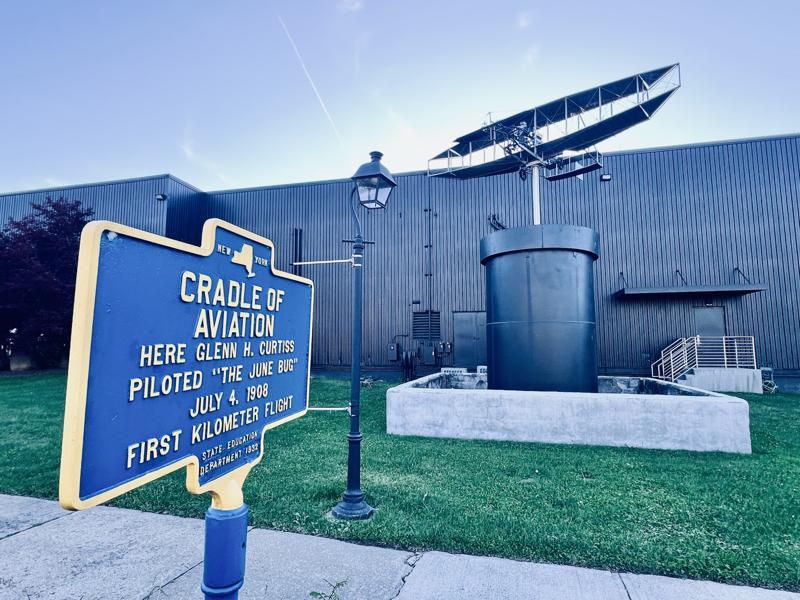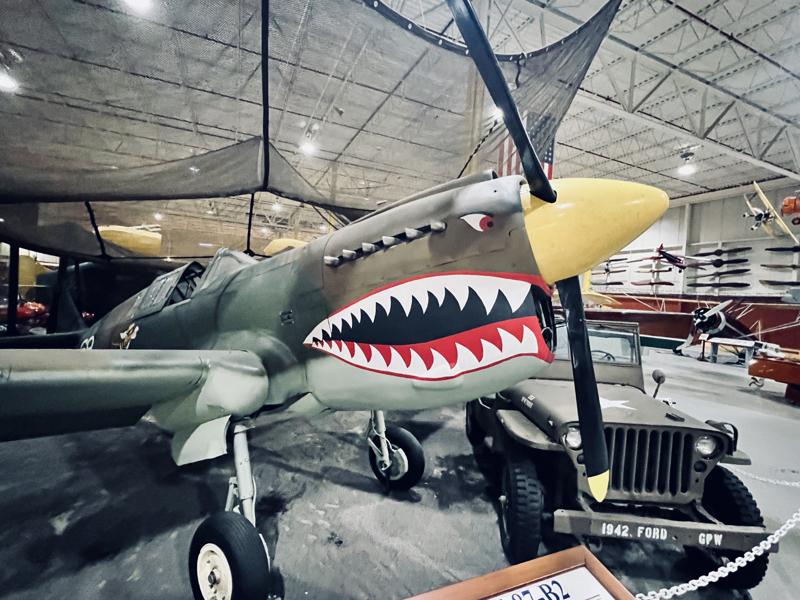Glenn H Curtiss Museum
Written By: Gail Clifford | Published By: Weekend Notes | September 14, 2024
Must-Visit for Aviation Enthusiasts in New York’s Finger Lakes

The Glenn H Curtiss Aviation Museum, tucked away in the picturesque New York Finger Lakes region, in Hammondsport just 30 minutes from Corning, NY, offers an immersive dive into the life of one of aviation’s most fascinating figures you may never have heard of: Glenn H. Curtiss. As you approach the museum, a striking scene welcomes you. A large aircraft is perched outside, almost like a sentry on the front lawn, inviting curious minds to step into Curtiss’ world of innovation and speed. To the side, a bright red caboose shouts out the region’s Champagne Trail, while an iron sculpture depicting an early flying machine—similar to the Wright Brothers’ iconic aircraft at Kitty Hawk, NC- hovers gracefully over the landscape.

Once inside, the museum takes you on a journey back in time. Your visit begins with a display of bicycles, a reminder of the humble roots of mechanized travel, before revealing the real treasures of Curtiss’ early life: motorcycles. Curtiss, after all, was dubbed “The Fastest Man on Earth” after being clocked in Ormond Beach, Florida racing his motorcycle to 218 kph (136 mph). His motorcycle designs, driven by his early obsession with speed, earned him that title. The museum captures the essence of this daring pioneer who, despite his modest upbringing and formal education that ended in the 8th grade, revolutionized motorized transport and aviation.
Curtiss’ story is both heartwarming and tragic. Left without a father or grandfather early in life, he grew up fast, protecting his mother and sister, who had lost her hearing to infection. His resourcefulness blossomed early, and he eventually found work creating stencils for The Eastman Company (later Eastman Kodak) in nearby Rochester. But his passion for speed ultimately led him to develop his own motorcycle engines, earning him acclaim at a competition in Florida where his motorcycle speed was formally timed. Yet, his wife’s fears were ever-present—after losing their young son to a congenital heart defect, she couldn’t bear the thought of losing her husband to his love of racing. Despite her pleas, Curtiss continued his pursuit of speed, though his heart soon turned to the skies.

In 1907, Curtiss’ first significant leap into aviation occurred when he was asked to pilot a dirigible designed by Thomas Scott Baldwin. His experience with engines and fascination with flight catapulted him into the world of aviation. Soon after, Curtiss became a founding member of the Aerial Experiment Association (AEA), an aviation research group led by none other than Alexander Graham Bell. Together with Bell and other innovators, Curtiss developed some of the most advanced aircraft of the time. In 1908, he piloted the June Bug, an aircraft that became the first to achieve a public flight of over one kilometer, earning him the Scientific American Trophy.
The museum shows Curtiss’ full journey into aviation, including his pivotal role in the development of the seaplane and naval aviation. Curtiss, ever the innovator, recognized the potential of amphibious flight. In 1911, he developed the Hydroaeroplane, an aircraft fitted with pontoons that allowed it to land and take off from water. This invention evolved into the world’s first seaplane, which revolutionized naval aviation. Curtiss opened the first-ever flying school in Hammondsport, where he trained the first generation of naval aviators, including Lieutenant Theodore Ellyson, the first naval officer to fly.
However, Curtiss’ success came with conflict. His groundbreaking work in aviation soon caught the attention of the Wright Brothers. The three pioneers became embroiled in a bitter patent war over who had the right to claim certain flight technologies, particularly the method of controlling an aircraft in flight. The Wrights accused Curtiss of patent infringement, and the legal battle lasted for years. Despite the tension, Curtiss continued to push the boundaries of aviation. Ultimately, their respective companies merged before Curtiss’ death, and the Wright-Curtiss legacy became inseparable from the history of flight.
Gail Clifford
Latest posts by Gail Clifford (see all)
- We Were Warned: An Anthology of Short Stories - October 23, 2024
- Exploring Dublin’s Royal Canal: A Journey Through Time and Nature - September 30, 2024
- The 8 Best Dr. Phillips Restaurants | Dr. Phillips, West Orlando, Florida - September 19, 2024
- Discover Cascais, Portugal - September 18, 2024
- The Ultimate Expat Guide How to Buy Property in Costa Rica, Ireland and the USA With Less Stress - September 17, 2024

0 Comments